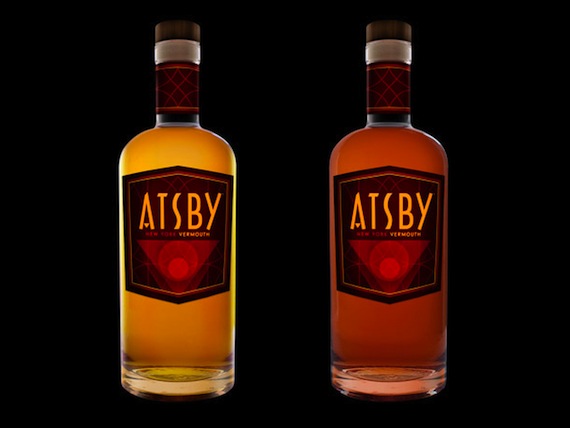We recently mentioned the American Vermouth Revolution, and felt like we didn’t do it justice. To dig a little deeper, we reached out to American Vermouth expert, Adam Ford, the founder of Atsby Vermouth.
Atsby made a splash at the 4th Annual Manhattan Cocktail Classic, and differentiated itself with its “new world” taste. It’s available in select states (MA, TN, IL, TX) for now, but we’re hoping it will make its way across the country soon.
Q. Why did you decide to stray from the traditional use of wormwood?
A. To say that wormwood was traditionally used in vermouth is accurate, but it doesn’t reflect the whole story. Although EU law requires the use of wormwood in vermouth, not even European producers use sufficient wormwood such that the flavor of it reaches anyone’s palate. Here, the use of wormwood is illegal – for all intents and purposes. Its active chemical component, Thujone, is prohibited in amounts any greater than 10 parts per million. Given our laws, it makes no sense to use it. I don’t want to lie to people and tell them I use wormwood because it was traditionally used, but only have put in a pinch in a few hundred gallons. (An idea I considered, but rejected). This reason alone was enough to keep me from using it.
Q. How do you think Atbsy Vermouth differs from other American-made vermouths?
A. I think the new vermouth movement in America that is going on right now is one of the coolest things happening in the craft spirits world. It’s so exciting to be among the first craft vermouth producers, all of whom are making great vermouths and collectively, changing people’s minds about this great category, and getting people into drinking vermouth again. I think what Atsby vermouth does that distinguishes itself is our use of the highest quality and novel base ingredients. We’re the first vermouth producer to use a vintage chardonnay as the base wine. Using such a beautiful fine wine to start gives us the perfect base structure to start building our vermouth. We then fortify our vermouths with craft apple brandy from all NY apples. No other vermouth producer, so far as we know, uses a fruit brandy (other than from grapes) to fortify their vermouth. And the use of apple brandy gives our vermouths the lush mouthfeel of a Calvados. Finally, the botanical pallet and sweeteners (raw summer honey, and caramel spun from dark Indian Muscovado sugar) that we use make our vermouths stand out and create great sipping vermouths.
Q. Being a vintage vermouth, every year your mix is a little bit different. How soon do you know if you’ve produced a good batch or not?
A. Being a vintage vermouth means that every year the potency and flavors of our base ingredients will be a little bit different. The vintage chardonnay will change slightly, the botanicals change in potency, the honey will change depending on what blooms that year, but we have been making vermouth long enough to know how to make slight adjustments to ensure that the vermouths maintain their balance. Different batches will taste slightly different, but those differences will be hardly noticeable. We are not making vintage vermouths in the sense that we’re switching our recipe and using different botanicals, wines, sweeteners, etc. We can tell the difference in batches after we’ve let our botanicals steep in the wine, which is for about a month. After that we can tell what adjustments need to be made based on that year’s vintage varieties.
Q. Do you think that Atsby Vermouth could replace the more traditional brands as mixers in vermouth cocktails?
A. Yes, but with a little explanation. Atsby vermouths are intended to enhance vermouth cocktails and give them more flavor, make them more interesting, and more drinkable by bringing additional flavors to the cocktail, rather than just bringing simple sweetness and a hardly noticeable bitter. Atsby Vermouths are not intended to be a straight substitute for the more traditional European brands and if you try to treat them as such, the results are unlikely to be great. The reason for this is that traditional vermouths have a lot of sugar, and so when they are used in cocktails they mostly add sweetness (even traditional dry vermouths have sugar added). Atsby vermouths don’t have that same simple sweetness, but rather are packed with subtle flavors that hit all five flavor profiles, sweet, sour, salty, bitter, and umami and so if you use too little Atsby vermouth in a cocktail, you risk washing away all of those flavors with the spirit. So Atsby Vermouths can certainly replace traditional brands, but they need to be treated a little differently. Many of this country’s best bartenders, such as Jeremiah Blake from the Holland House Bar and Refuge in Nashville, and Garry Severin from the Lamb’s Club in NYC, and Sother Teague from Amor Y Amargo in NYC have figured this out and created amazing cocktails that are built around Atsby Vermouth, many of these recipes are all on our website. We also frequently post recipes of the day on twitter @atsbyvermouth.
Q. What’s your favorite way to drink Atsby Vermouth?
Neat, chilled, and quickly.


